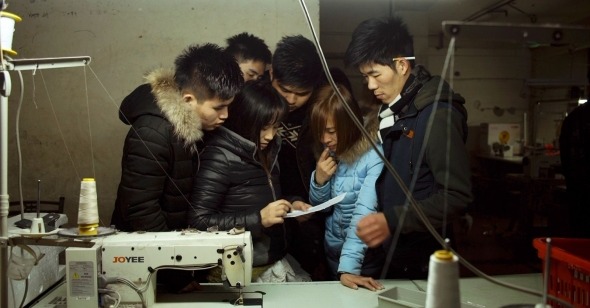Insiders
By Dan Schindel
Youth (Spring)
Dir. Wang Bing, France/Luxembourg/Netherlands, Icarus Films
Each year, around 300,000 migrant laborers come to Huzhou, a major textile hub in eastern China, seeking jobs at 18,000 different small workshops. From 2014 to 2019, filmmaker Wang Bing embedded himself in the population there. By his reckoning, he and his crew shot 2,600 hours of footage. He’s since turned this material into different works. Bitter Money (2016) is a conventionally structured documentary following a contained cast of subjects as they journey from their rural townships and then struggle to find their places in the industry. The next year Wang released 15 Hours, an installation piece comprising a single shot of a sewing machine workstation which lasts for the titular stretch of time. This project continues with 2023’s Youth (Spring), which exists in the middle ground between Bitter Money’s observational portraiture and 15 Hours’s durational experimentation.
Youth (Spring) may at first blush seem redundant coming after Bitter Money, as it touches on the same basic premise (migrants hustling to survive), is set in the same place (Huzhou), and deals with the same subject (workshop labor). But this new film is distinguished in structure, aesthetics, and character. The most apparent difference is evident from the title. While Bitter Money followed a variety of people across a range of ages, nearly all the subjects here are young people. Most are in their early 20s, though there are plenty of teenagers too—the youngest we meet is 16.
Moving away from the more adult concerns in Bitter Money, like marital abuse and the anxiety of providing for children, Youth (Spring) offers a dramatic shift in perspective. In an early sequence, the parents of one 19-year-old woman bargain with the owner of her workplace for assistance in procuring her an abortion, emphasizing how little agency and power she and other young people possess. A major narrative thread in the film sees the characters figuring out what kind of self-determination they can seize, as they repeatedly negotiate with their bosses for higher wages. Payment is made based on how many garments—in the workshops seen here, children’s clothing—an employee can produce over a 10- or 12-hour (or longer) shift. The collective action and occasional victories threaded throughout steer the film from any miserabilist tendency, which can sometimes overtake labor films to the occlusion of humanity.
Reinforcing this is how much we see the kids play pranks, bum around, and flirt with one another. Youth (Spring) emerges as a compelling depiction of the overlooked but crucial fucking-around element of work. Anyone who’s been at a dull, repetitive job understands innately the odd camaraderie bred from shared unfulfillment and hardship. Add to this the roiling torments of hormones and low thresholds for patience, and you have endless possible permutations for shenanigans. Which is not to say that the documentary filters out this milieu’s grimness. Sometimes frustration explodes in petty anger rather than being coolly vented, like when a brawl nearly breaks out over a tossed lighter.
But the point to which these impressions build is not always clear. Wang is no stranger to extended runtimes, with more features over three hours than under in his oeuvre(2002’s West of the Tracks and 2018’s Dead Souls are both more than eight).Here, though, it’s difficult to detect the utility of certain scenes and sequences, either on their own or within the broader project. His films tend to emphasize either narrative (Ta’ang) or character (Mrs. Fang). This one splits the difference, but often loses track of the characters, especially since there are so many introduced, with new faces appearing even toward the end. If the collective rather than individual experience is the focus, then details like the title cards accompanying each subject feel superfluous. The film feels oddly caught between finding novel ways to observe its environment and directly conveying its subjects’ boredom. It may be too long for the former and not long enough to accomplish the latter.
Wang’s eye is, nevertheless, more exacting than ever, guiding the film through structural uncertainties. In works like Ta’ang or Mrs. Fang, he’s demonstrated an almost uncanny ability to alight upon artful compositions for moments both dramatic and mundane. Here the camera so easily settles into a familiar rapport with the young folks that it’s easy to miss that you’ve adopted the point of view of sitting in one workstation among many. This reflects Wang’s self-imposed limitation of the film’s scope: it rarely leaves the workshops or dorms. The sun often seems like a distant memory.
This conceit is meaningfully broken in the final sequence, which follows one of the workers back to his hometown. After more than three hours of screaming sewing machines and Mando-pop buzzing from phones, the silence of the countryside is a balm. He’s working to support his family here, but to do so he’s torn himself away from it. From his first film, the gargantuan three-part West of the Tracks, Wang has been concerned with the devastating personal sacrifices of labor in China amid the country’s rising capitalist tide. Youth (Spring) is supposedly the start of a new trilogy. It’s not known how he’ll further mine the thousands of remaining hours of footage, although the climactic expansion from the urban to the rural here may be a hint. Further characterizing and distinguishing the different workers would make this enterprise continue to feel generative. The subject matter may be stultifying, but Wang has already more than proven his ability to bring it to life.
